Music Appreciation Who said “At one time they tried to make music give people pleasure - now they torture and tire them”? Tchaikovsky said this after hearing Wagner’s Ring at Bayreuth in 1876 - BBC Music, December, 2002
Содержание
- 3. Wagner and the Romantic Movement Romantic movement is expressed best by Wagner’s music Music Dramas Practiced
- 4. Wagner's life and career b. 1813 in Leipzig Little formal musical training Wrote he words and
- 5. Wagner's life and career Left Dresden for Switzerland where he lived in exile Sketched out a
- 6. Schwanstein photo courtesy of Ellen Congleton
- 7. Neuschwanstein photo courtesy of Ellen Congleton
- 8. The "Complete Work of Art" Wagner believed that art and opera must be more than a
- 9. The Wagner Tuba A relative of the horn, it was invented in the late 1800's to
- 10. Besides the operas, Wagner regarded himself as "the most German of men” and "the German spirit"
- 11. Wagner’s Family Tree Parents: Carl Friedrich Wilhelm Wagner (1770-1813), Richard's real father was probably Ludwig Geyer
- 12. Festspielhaus photo courtesy of Ellen Congleton
- 13. Outside Wagner’s Home photo courtesy of Ellen Congleton
- 14. Bayreuth Wagner’s idea was to create a "mystical abyss" separating the real world (the viewers) from
- 15. Tristan Chord
- 16. RICHARD WAGNER (1813 - 1883) The Ring
- 17. der Ring des Nibelungen Nibelungenlied is a Medieval German legend The Ring of the Nibelung Das
- 18. der Ring des Nibelungen 3 Norns Erda Rhinemaidens (guarding the gold in the Rhine) Walkures (Brunhilde
- 19. Richard Wagner Gesamtkunstwerk Bayreuth Endless melody Leitmotifs Chromatic harmony
- 20. Star Wars and The Ring Star Wars Conceived as a series of nine films it was
- 21. Star Wars v/s The Ring Lucas creates his own film studio, his own company for creation
- 22. Star Wars v/s The Ring The Star Wars is a simple tale of good and evil,
- 23. Wagner Quiz 1. Which composer has been considered to be the single most important phenomenon in
- 24. Wagner Quiz 2. Wagner’s cycle of four music dramas is called: A - Lohengrin B -
- 25. Wagner Quiz 3. Wagner called his operas: A - tone poems B - music dramas C
- 26. Wagner Quiz 4. The principal themes in Wagner’s operas, which recur throughout a work and carry
- 28. Скачать презентацию

















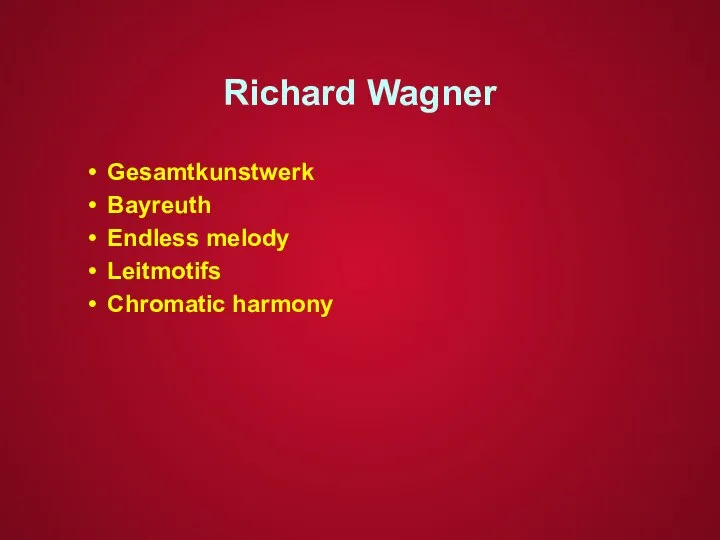

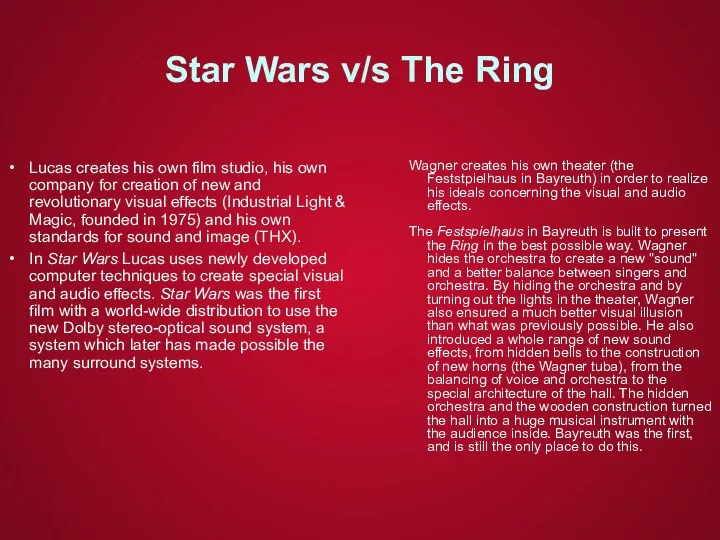
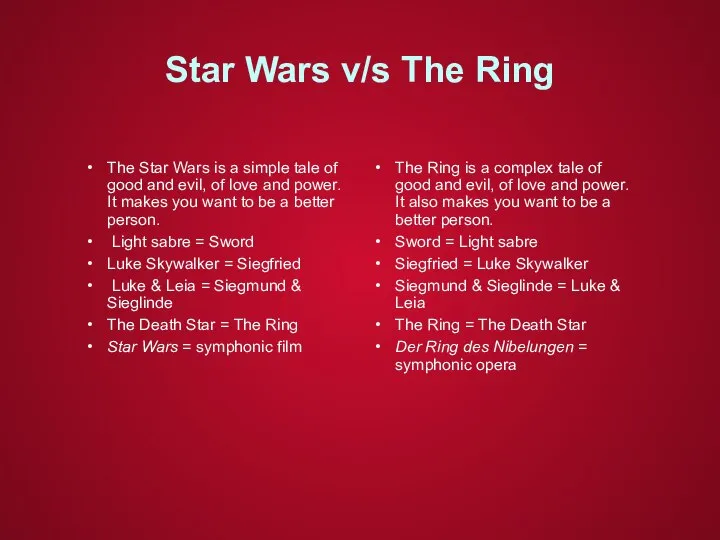

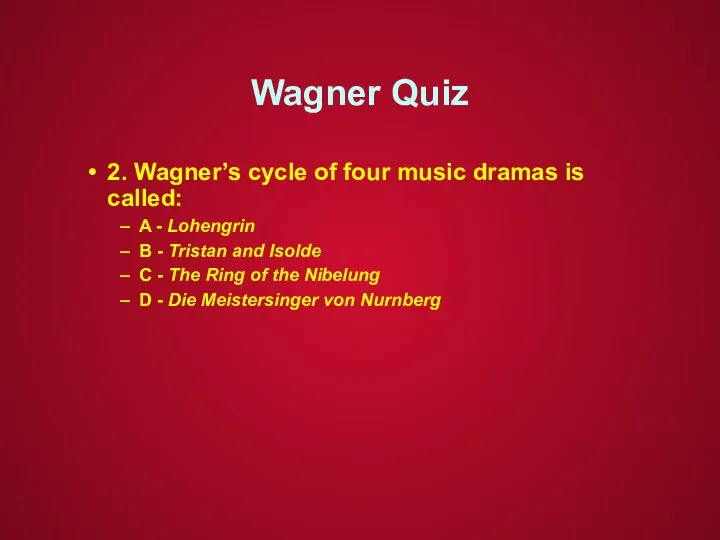
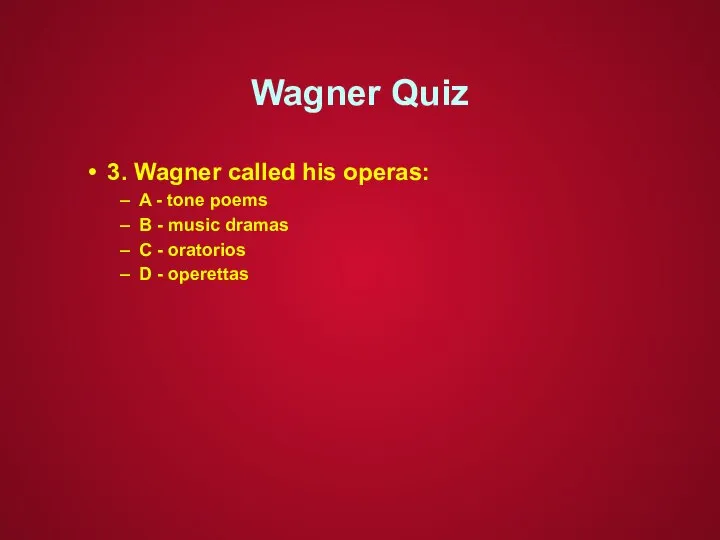
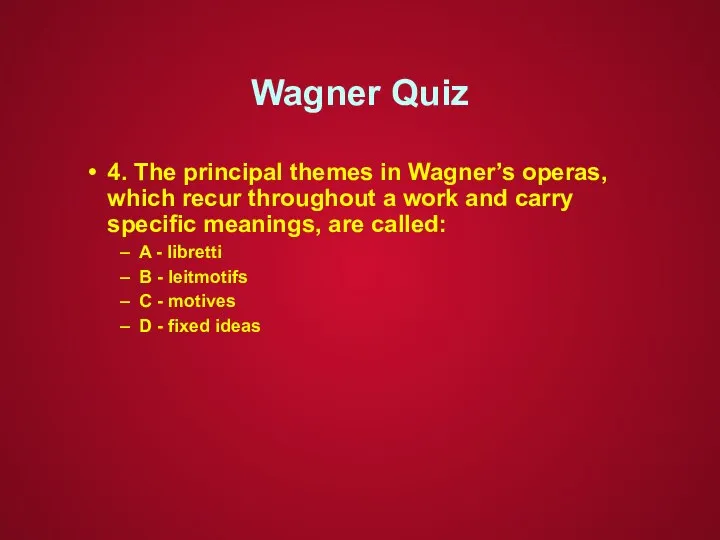
 Выполнила Альберти Мария ученица 8 класса МОУ Чикманской СОШ
Выполнила Альберти Мария ученица 8 класса МОУ Чикманской СОШ  Викторина №2 Who knows English well
Викторина №2 Who knows English well My Favourite English writer
My Favourite English writer  Презентация к уроку английского языка "Deforestation" - скачать бесплатно
Презентация к уроку английского языка "Deforestation" - скачать бесплатно Презентация к уроку английского языка "Food" - скачать
Презентация к уроку английского языка "Food" - скачать  СЛОВАРЬ / DICTIONARY Словарь - это вся вселенная в алфавитном порядке! Если хорошенько подумать, словарь – это книга книг. Он включает в
СЛОВАРЬ / DICTIONARY Словарь - это вся вселенная в алфавитном порядке! Если хорошенько подумать, словарь – это книга книг. Он включает в  EXPLORING SPACE
EXPLORING SPACE  Подарки Автор: учитель начальных классов ГБОУ ЦО № 1456 Симбирева Дарья Викторовна
Подарки Автор: учитель начальных классов ГБОУ ЦО № 1456 Симбирева Дарья Викторовна  Правило написания английского письма. Якубовской Кати 6 “Л”
Правило написания английского письма. Якубовской Кати 6 “Л” Cards with regular verbs
Cards with regular verbs Презентация к уроку английского языка "London – Capital of UK" - скачать
Презентация к уроку английского языка "London – Capital of UK" - скачать  REVISION UNIT 3 CIVILISATION AND PROGRESS SECTION 1 LEARNING FROM THE PAST
REVISION UNIT 3 CIVILISATION AND PROGRESS SECTION 1 LEARNING FROM THE PAST Презентация к уроку английского языка "Money" - скачать
Презентация к уроку английского языка "Money" - скачать  Institute of Physics
Institute of Physics Выполнила ученица 7»б» класса Емельяненкова Мария МОУ Иловлинская СОШ №2
Выполнила ученица 7»б» класса Емельяненкова Мария МОУ Иловлинская СОШ №2  Активизация и развитие навыков говорения на уроке иностранного языка
Активизация и развитие навыков говорения на уроке иностранного языка Speaking First Dates
Speaking First Dates Battleship. Board games
Battleship. Board games The Unique Australian Wildlife The notes to the geological history of the continent By Maria Skochilova School 7 Nizhny Tagil
The Unique Australian Wildlife The notes to the geological history of the continent By Maria Skochilova School 7 Nizhny Tagil Present Simple
Present Simple Кластер на уроках английского языка Учитель английского языка МОУ «Парбигская сош» Романова Л.А.
Кластер на уроках английского языка Учитель английского языка МОУ «Парбигская сош» Романова Л.А.  Amazing luck Prepared by Olga Khropina and Elena Filippova
Amazing luck Prepared by Olga Khropina and Elena Filippova What is the number of these apartments
What is the number of these apartments Урок английского языка для 6 класса по учебнику К.И Кауфман, М.Ю.Кауфман Happy English.ru We are fond of pets Учитель: Корнилова Наталья Геннадье
Урок английского языка для 6 класса по учебнику К.И Кауфман, М.Ю.Кауфман Happy English.ru We are fond of pets Учитель: Корнилова Наталья Геннадье The Spring Party the invitation
The Spring Party the invitation  Living and spending. Spotlight 10
Living and spending. Spotlight 10 Verb To be. Pronouns
Verb To be. Pronouns The Problem of Belles-Lettres Style
The Problem of Belles-Lettres Style